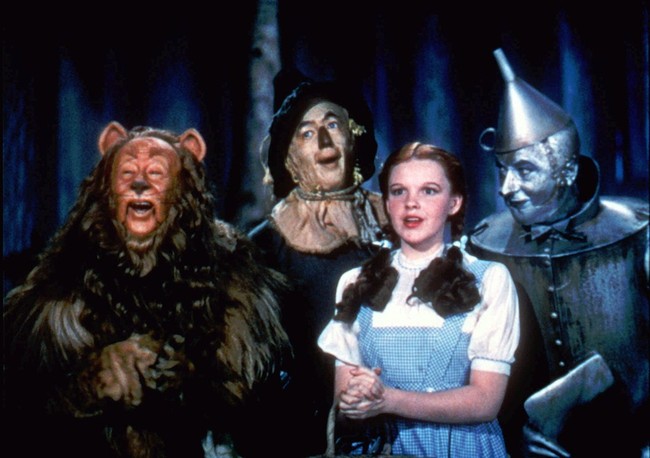I grew up on The Wizard of Oz, worshipped the ruby slippers, and still find it odd that a recent essay treats the movie as a disguised lecture on gender and power while ignoring the obvious: it’s a girl’s fantastical panic dream after a bump on the head.
I was very young when I first saw The Wizard of Oz and the ruby slippers stuck with me like a childhood shrine. By five I wore a homemade Dorothy costume with red-glittered shoes my dad painstakingly made with rubber cement and a lot of patience. Those simple memories explain why the auction news about real ruby slippers still stung a little when they sold for $28 million, rising to $32.5 million after the buyer’s premium.
I did not win the auction and I have never been a serious collector, but the price tag was a reminder that pop culture artifacts turn into high-dollar curios. I’ve never been deeply invested in the contemporary expansions of Oz, and I skipped most versions of Wicked. I like the song “Defying Gravity,” but otherwise my interest is casual at best.
That said, a recent long-form piece about Oz in an entertainment outlet grabbed my attention for the wrong reasons. The author reads the film as a staged commentary on matriarchy and patriarchy, spinning the story into a thesis about fear and gender politics. I found that reading strained and oddly literal for what is, I think, a much simpler allegory and a memorable family movie.
And here’s the sleight-of-hand trick of it all. The land of Oz doesn’t present itself as a matriarchy. The most powerful figure in the kingdom is a man: the Wonderful Wizard of Oz. Everyone drops his name in awed tones. The regal Glinda defers to him. Even the imperious Wicked Witch is intimidated by his power. So the land of Oz, in form, is a traditional patriarchy.
Except that it’s not. Because what we finally learn is that “the Wizard of Oz” doesn’t exist. That looming patriarchal monarch is an illusion, a hologram glimpsed through smoke and fire. Glinda and the Wicked Witch of the West really are the two most powerful figures in Oz. And as you look more closely at Margaret Hamilton’s extraordinary performance as the Wicked Witch, another level of this phantasmagorical landscape clicks into place, a kind of submerged reverie of identity.
What is it about the Wicked Witch that’s so uniquely scary and mesmerizing? It’s that Hamilton invests her with a look and energy that fuses the masculine and the feminine. The movie is telling us, in a nightmare way, what is going to frighten people about matriarchy: the primal anxiety that women will subsume and replace men. That fear asserts itself in the homicidal gaze of Hamilton’s presence. The Wicked Witch’s dream mission is to murder femininity (“My pretty!”).
But this, in fact, is a perversion of what true matriarchy is. The more enlightened version is the one presented by Dorothy and her three friends: the Scarecrow, the Tin Man, and the Cowardly Lion, all visions of men who have had their power taken away. Yet their love for Dorothy is real; that’s what their power becomes — the desire to transcend their goofball selves by protecting her.
Reading that, I kept thinking: huh. In decades of watching the movie, singing “Over the Rainbow,” and surviving annual network broadcasts, I never walked away with a “smash the patriarchy” vibe. The story feels more like a cautionary fairy tale filled with quirky moral figures than a political manifesto about gender. You can force any cultural artifact into a theory if you twist hard enough, but that doesn’t make the theory convincing.
Consider the basics: one witch is bent on killing a girl, and the other witch, Glinda, allows Dorothy to wander into danger even while knowing she could have sent Dorothy home earlier. That reads as poor guardian logic, not as a deliberate endorsement of female rule. If anything, that mismatch of action and consequence undercuts a neat political reading.
Why Does 'The Wizard of Oz' Still Cast Such a Wicked Spell? Because It's the Movie That First Flipped the Patriarchy on Its Head https://t.co/ztr526FSR2
— Variety (@Variety) November 23, 2025
Also, the trio who rally around Dorothy are male figures who grow and learn to protect her through acts of courage and compassion. The Scarecrow, the Tin Man, and the Cowardly Lion earn what they lack, and their devotion becomes the film’s emotional backbone. Claiming the film is mainly a warning about matriarchy forgets how much of the movie celebrates friendship, bravery, and simple human change.
I’m not fond of retconning classic stories to match modern social theories, especially when the original narrative is so clearly an imaginative kid’s tale. Turning every beloved plotline into a political case study risks stripping away the joy and mystery that made those stories enduring. Critics can find patterns if they look, but pattern hunting is not the same as faithful reading.
Finally, the simplest and most literal interpretation is still on the table: Dorothy gets knocked out, dreams a vivid, strange sequence, and wakes up back home. The film plays out like a fever dream with memorable characters and striking imagery, not a careful essay on governance and gender. That plain fact feels like the missing center of many of these overreaching takes.
So don’t be surprised if fans bristle when critics drape a political banner over a childhood favorite and call it scholarship. Sometimes a witch is just a witch, and a dream is just a dream. That doesn’t make the discussion worthless, but it does mean we should keep our readings proportional to the evidence on screen.






